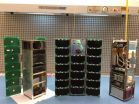(Press-News.org) At any given moment, our sun emits a range of light waves far more expansive than what our eyes alone can see: from visible light to extreme ultraviolet to soft and hard X-rays. Different wavelengths can have different effects at Earth and, what's more, when observed and analyzed correctly, those wavelengths can provide scientists with information about events on the sun. In 2012 and 2013, a detector was launched on a sounding rocket for a 15 minute trip to look at a range of sunlight previously not well-observed: soft X-rays.
Each wavelength of light from the sun inherently carries information about the kind of process that emitted the light, so looking at soft X-rays provides a new way to figure out what is happening on our closest star. For example, the sun's atmosphere, the corona, is 1,000 times hotter than its surface, and scientists do not yet understand the details of why. The soft X-ray detector brought home data showing that a significant amount of soft X-rays - more than expected - were seen when there are even a small amount of magnetically complex sunspots. Identifying what process within these magnetically active regions contributes to the great increase in soft X-rays could hold clues for what's helping to heat the corona. A paper on these results appeared in the Astrophysical Journal Letters on March 18, 2015.
"Not only did we gather measurements that haven't been made routinely," said Amir Caspi, first author on the paper and a solar scientist at Southwest Research Institute in Boulder, Colorado, who worked at the University of Colorado in Boulder during the course of this study. "The detector we used also allowed us to gather the best measurements so far made in this energy range."
This soft X-ray detector hitched a ride into space on a NASA sounding rocket. During a 15 minute total flight, sounding rockets have about six minutes of time to gather data from space. The soft X-ray detector and its related components are only about the size of a pack of cards, so it could easily fly on board a rocket carrying another experiment - in this case, one that helps calibrate the Extreme Ultraviolet Variability Experiment, or EVE, on NASA's Solar Dynamics Observatory. Sounding rockets and combining missions on a single launch vehicle provide an opportunity to conduct world-class science with a lower price tag.
The soft X-ray detector flew first on June 23, 2012, and again on October 21, 2013.
During both flights, there were only a few complex active regions on the sun's surface - indeed, very few during the 2012 flight. Yet, in both flights the detector saw 1000 times more soft X-rays than had been seen by another experiment in 2009. Even a slight extra amount of solar activity in the form of these active regions, led to substantially more output in the soft X-ray wavelengths.
Wavelengths of light correlate to particular temperatures of material on the sun, and this abundance of soft X-rays points to clouds of hot - 5 to 10 million degrees - gases above the active regions that wasn't present during the 2009 measurements when there were no active regions on the sun. That kind of information makes it clear that different heating mechanisms occur on the quiet sun and active regions, opening the door to determining the differences. One theory for the source of this mysterious heating is that numerous tiny explosions called nanoflares are constantly erupting on the sun. Nanoflares are too small to be seen by our telescopes, but powerfully energetic nonetheless. The soft X-rays might well be a result of nanoflares, thus giving us a way of investigating them.
The new soft X-ray data differed from previous data studies in another respect as well. By parsing out the amounts of each individual wavelength of light gathered, the team could identify what elements were present in the corona. Typically, the abundance of some of these atoms in the corona is greater than at the sun's surface. But not so in these recent observations. The mix of material in the corona was more similar to the mix seen at the solar surface, suggesting that some material from the surface was somehow rising up higher into the atmosphere.
"The difference we see in the abundances of the elements compared to previous studies suggest there may be a link between the heating mechanism and the coronal composition," said Caspi.
Untangling the elements present on the sun's surface and in its atmosphere during different events on the sun could offer another set of tools for interpreting what heats the corona.
Discovering that the soft X-ray emission was brighter than supposed has effects for understanding space weather events near Earth as well. Different wavelengths of light from the sun penetrate to different layers of Earth's atmosphere, causing different effects.
"The solar soft X-rays are deposited lower in Earth's atmosphere than the sun's extreme ultraviolet radiation," says Tom Woods, a co-author on the paper and the principal investigator for this experiment at the University of Colorado in Boulder. "The soft X-rays cause almost instantaneous changes in the ionosphere that can disturb radio communications and the accuracy of GPS navigation systems."
Such changes in the ionosphere happen during large explosions on the sun called solar flares. As humans attempt to better understand - and predict - the sun's effects on the space through which our communication signals travel, it's crucial that we have accurate models to simulate what the sun is sending our way and when.
The soft X-ray results so far are based on what amounts to only 10 minutes worth of data. However, this early data clearly shows the value of observing the previously understudied soft X-ray emissions. In the hopes of getting a longer data record - and of observing soft X-rays from solar flares -- the team has been working to place the same kind of detector into the NASA-funded Miniature X-ray Solar Spectrometer, or MinXSS, CubeSat, currently scheduled to launch in late 2015. About the size of a loaf of bread, the MinXSS is part of NASA's CubeSat program, which started in October 2013. CubeSats are small satellites that ride along with larger missions to take advantage of yet another low cost way to perform experiments in space. MinXSS will provide 6-12 months of observations to advance our understanding of soft-X-ray emissions from the sun both from solar flares and during quiescent periods.
The soft X-ray detector used for this experiment was an Amptek X123-SDD.
INFORMATION:
For more on NASA's sounding rocket program:
http://www.nasa.gov/soundingrockets
Using data from orbiting observatories, including NASA's Spitzer Space Telescope, and ground-based facilities, an international team of astronomers has discovered an outburst from a star thought to be in the earliest phase of its development. The eruption, scientists say, reveals a sudden accumulation of gas and dust by an exceptionally young protostar known as HOPS 383.
Stars form within collapsing fragments of cold gas clouds. As the cloud contracts under its own gravity, its central region becomes denser and hotter. By the end of this process, the collapsing fragment ...
Over the last 30 years, short sight, or myopia, has become a global health problem. The most dramatic rise has been in Singapore, Taiwan, China's cities and elsewhere in East Asia. Rates can be as high as 80-90 per cent among children leaving secondary schools in the region. As many as a fifth of them have severe myopia and so are at high risk of eye problems in later life. In Western countries rates are increasing; although not as rapidly as in East Asia.
The Myopia Mystery
The cause of myopia, and the means to prevent it, are unclear despite more than 150 years of ...
Bethesda, MD (March 24, 2015) -- A new guideline from the American Gastroenterological Association (AGA) changes clinical practice by recommending longer surveillance periods for patients with asymptomatic pancreatic cysts and new criteria that limits surgery to those who will receive the most benefit.
It is estimated that more than 15 percent of patients who visit a doctor's office or hospital outpatient department will receive an MRI or other type of scan,2 and of those, about 15 percent will have incidental pancreatic cysts. Once detected, these cysts trigger anxiety ...
Washington, DC (March 24, 2015) - As congenital heart disease (CHD) treatment advances, children with these conditions are living into adulthood, and over time, they may need additional treatment. A new expert consensus paper released today by the Society for Cardiovascular Angiography and Interventions (SCAI), American Association for Thoracic Surgery (AATS), American College of Cardiology (ACC), and The Society of Thoracic Surgeons (STS) provides guidance on transcatheter pulmonic valve replacement, or tPVR, for children and adults who were previously treated for CHD.
Pulmonary ...
DETROIT - Major League Baseball pitchers who underwent a second Tommy John surgery saw their performance decline and their career shortened, according to researchers at Henry Ford Hospital.
In a retrospective, case-controlled study, researchers analyzed performance and longevity data of 33 pitchers who had a second surgery following the original elbow reconstruction between 1996 and 2012 and compared them with pitchers of similar age who had no prior Tommy John surgery. Key findings for pitchers after a second surgery:
65 percent returned to pitching at MLB level.
On ...
This news release is available in French. Socio-economic inequalities between First Nations communities, and also between these communities and the non-Aboriginal population of Canada, determine the nature, the intensity and the direction of First Nations migration flows. Pursuing educational careers, finding work, and seeking better health and living conditions are the main reasons for First Nations migration. These are the findings of research by Marilyn Amorevieta-Gentil, Robert Bourbeau and Norbert Robitaille, of the University of Montreal, which were presented ...
DURHAM, N.C. -- For people infected with the human papilloma virus (HPV), the likelihood of clearing the infection and avoiding HPV-related cancer may depend less on the body's disease-fighting arsenal than has been generally assumed.
A new study finds that the body's ability to defeat the virus may be largely due to unpredictable division patterns in HPV-infected stem cells, rather than the strength of the person's immune response.
If the mathematical model behind the findings holds up, it could point to ways of tweaking the way infected cells divide in order to make ...
It's no surprise that some of the most celebrated leaders in the business world also happen to be self-promoting narcissists.
New research from Brigham Young University's Marriott School of Management finds those strong characteristics are not such a bad thing--as long as those leaders temper their narcissism with a little humility now and then.
"Just by practicing and displaying elements of humility, one can help disarm, counterbalance, or buffer the more toxic aspects of narcissism," said Bradley Owens, assistant professor of business ethics at BYU. "The outcome ...
Great leaders are often good communicators. In the process of communication, the relationship between leaders and their followers develops spontaneously according to new research from the Max Planck Institute for Human Cognitive and Brain Sciences in Leipzig and the State Key Laboratory of Cognitive Neuroscience and Learning and IDG/McGovern Institute for Brain Research in Beijing. When a member becomes the group leader, the leader's brain activity in the left temporo-parietal junction, known as representing others' mental states, begins to synchronize with that in the ...
Adding two non-invasive imaging tests to traditional cardiovascular disease risk factor assessment more precisely predicts a healthy patient's future risk of heart attack, stroke, or premature death, according to a study led by Icahn School of Medicine at Mount Sinai and published in the March 24 edition of the Journal of the American College of Cardiology (JACC).
"Using imaging tests to detect disease in carotid or coronary arteries before it causes symptoms can better identify healthy individuals at increased risk than our current, traditional risk assessment methods," ...


